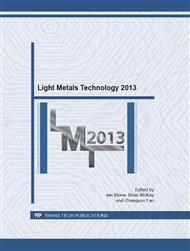p.771
p.776
p.783
p.788
p.793
p.798
p.803
p.808
p.813
Tensile Strength of Al-Zr Overhead Line Conductors
Abstract:
Aluminium and its alloys are used in all bare overhead energy transmission lines. Researchers and manufacturers, have in the past, made significant improvements in the tensile strength and conductivity of overhead lines. In the present work, the effect of heat treatments on the tensile strength of Al-Zr alloys (Al-0.15, 0.20, 0.25wt.%Zr) has been investigated (all compositions hereafter are described in wt.%). The Al-Zr samples were prepared by using a melt furnace and a continuous casting line. The cast, extruded and drawn samples with different diameters (4, 6, 10 mm) were aged isothermally and isochronally in muffle and tube furnaces. Aging was performed over a wide range of temperatures (350-450 °C) at constant aging times (100 hrs., 125 hrs.) and over a wide range of aging times (50-150 hrs.) at a constant temperature (425 °C). It was found that, aging temperatures, aging times, composition, processing techniques and size of the samples affect the tensile strength.
Info:
Periodical:
Pages:
793-797
Citation:
Online since:
July 2013
Authors:
Keywords:
Price:
Сopyright:
© 2013 Trans Tech Publications Ltd. All Rights Reserved
Share:
Citation:


